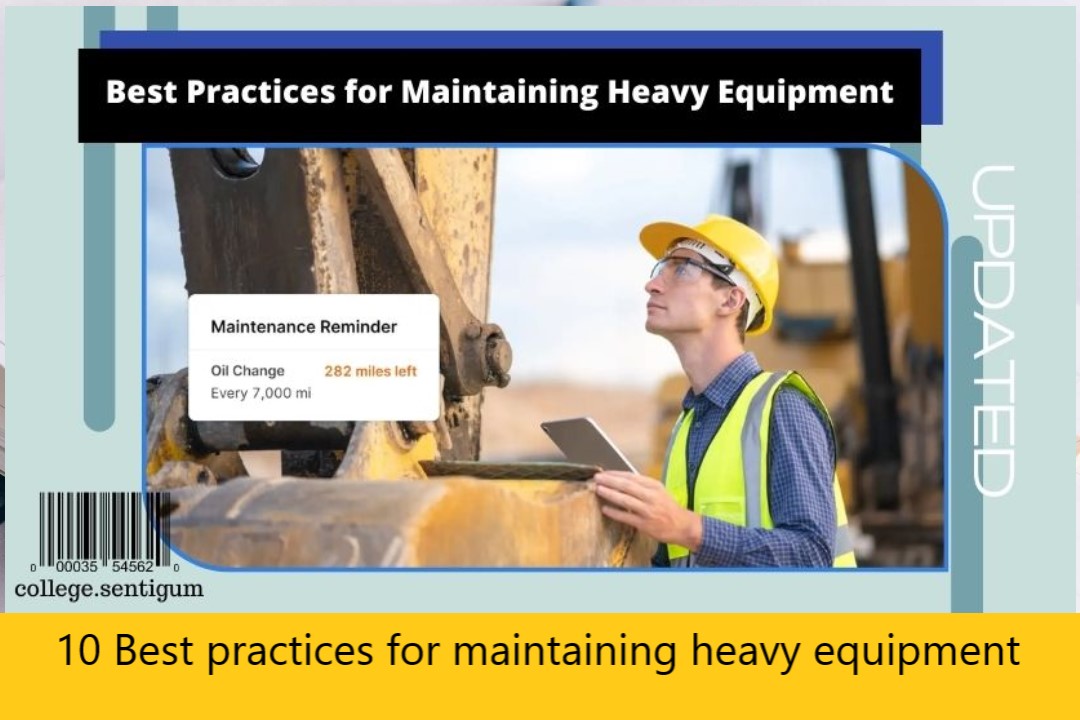10 Best practices for maintaining heavy equipment

Kworld Trend / 10 Best practices for maintaining heavy equipment, Construction equipment maintenance refers to the set of activities and practices aimed at ensuring the proper functioning, reliability, and longevity of construction machinery and equipment
10 Best practices for maintaining heavy equipment
It involves systematic inspections, servicing, repairs, and replacements to keep the equipment in optimal operating condition.
The primary goals of construction equipment maintenance are: Preventive Maintenance, Corrective Maintenance, Scheduled Maintenance, and Unscheduled Maintenance.
Construction equipment maintenance is crucial to ensure the safety of personnel, prevent costly downtime, optimize equipment performance, and maximize the return on investment in construction machinery.
By implementing effective maintenance practices, construction companies can minimize unexpected breakdowns, extend the life of their equipment, and improve overall project productivity.
Tips For Maintaining High Performance Equipment
Maintaining heavy-duty equipment is crucial for its optimal performance, longevity, and safety.
Here are some valuable tips for maintaining your heavy-duty equipment:
Follow Manufacturer Guidelines
Familiarize yourself with the manufacturer’s guidelines and recommendations for maintenance.
The manufacturer’s manual provides specific instructions regarding maintenance schedules, fluid types, lubrication points, and other essential maintenance tasks.
Adhering to these guidelines ensures that you are properly maintaining the equipment as recommended by the experts.
Implement a Preventive Maintenance Program
Develop and implement a proactive preventive maintenance program for your heavy-duty equipment.
This program should include regular inspections, servicing, and replacement of components at specified intervals.
By addressing potential issues before they escalate, you can prevent unexpected breakdowns and costly repairs.
Conduct Regular Inspections
Perform thorough inspections of your equipment on a regular basis.
Check for signs of wear, damage, leaks, loose connections, and abnormal sounds or vibrations.
Inspect critical components such as engines, hydraulic systems, electrical systems, tires, tracks, and structural elements.
Promptly address any issues that you discover during the inspections.
Keep It Clean
Regularly clean your heavy-duty equipment to remove dirt, debris, and corrosive substances.
Use appropriate cleaning methods and products recommended by the manufacturer.
Pay special attention to areas prone to dirt buildup, such as radiator fins, engine compartments, and air filters.
Keeping your equipment clean helps prevent corrosion, maintains proper cooling, and ensures optimal performance.
Lubrication
Adequate lubrication is vital for heavy-duty equipment.
Follow the manufacturer’s recommendations for lubrication intervals and use the correct type and grade of lubricants.
Regularly grease fittings and moving parts to minimize friction, reduce wear, and extend the lifespan of critical components.
Monitor Fluid Levels and Quality
Regularly check and maintain proper fluid levels in your equipment, including engine oil, hydraulic fluid, coolant, and transmission fluid.
Inspect fluid quality for contamination, such as water or debris.
Replace fluids as necessary, following the manufacturer’s specifications.
Clean and replace filters regularly to keep fluids free from contaminants.
Train Operators
Ensure that equipment operators are properly trained in operating procedures and basic maintenance tasks.
Well-trained operators can detect early signs of equipment issues, report them promptly, and follow appropriate maintenance practices.
Operator error can contribute to equipment wear and damage, so proper training is essential.
Track and Document Maintenance
Maintain detailed records of all maintenance activities, including inspections, repairs, part replacements, and servicing.
Documenting maintenance tasks helps track equipment history, identify recurring issues, and plan for future maintenance needs.
It also assists in warranty claims and provides valuable information for equipment resale.
Work with Qualified Technicians
For complex maintenance tasks or repairs, work with qualified technicians who have experience and expertise with your specific equipment.
They can provide specialized knowledge, perform intricate repairs, and ensure that maintenance tasks are conducted correctly and efficiently.
Safety First
Prioritize safety during maintenance activities.
Follow appropriate lockout/tagout procedures, use personal protective equipment (PPE), and be mindful of hazards.
Ensure that the equipment is properly supported or secured during maintenance tasks to prevent accidents.
Best Practices for Maintaining Heavy Equipment
Maintaining heavy equipment is essential for maximizing its lifespan, ensuring safe operation, and minimizing costly breakdowns.
Here are some best practices for maintaining heavy equipment:
Regular Inspections
First Best Practices for Maintaining Heavy Equipment is regular inspections.
Perform routine inspections of the equipment to identify any signs of wear, damage, or potential issues.
Inspect critical components such as engines, hydraulic systems, tires, belts, hoses, and electrical connections.
Follow the manufacturer’s guidelines for inspection intervals.
Lubrication
Second Best Practices for Maintaining Heavy Equipment is Lubricantion.
Proper lubrication is crucial for heavy equipment. Regularly grease all appropriate fittings and components as per the manufacturer’s recommendations.
Use the correct lubricants and ensure proper distribution of grease to minimize friction and extend the life of moving parts.
Fluid Checks and Changes
Third Best Practices for Maintaining Heavy Equipment is fluid checks and changes.
Regularly check fluid levels, including engine oil, hydraulic fluid, coolant, and transmission fluid.
Top up or change fluids as needed, following the manufacturer’s guidelines.
Contaminated or low fluid levels can lead to equipment failure.
Filter Maintenance
Fourth Best Practices for Maintaining Heavy Equipment is filter maintenance.
Clean or replace filters, such as air, fuel, and hydraulic filters, according to the manufacturer’s recommendations. Clogged filters can reduce equipment performance and cause damage to critical systems.
Cleaning
fifth Best Practices for Maintaining Heavy Equipment is cleaning.
Keep heavy equipment clean by removing dirt, debris, and other contaminants. Use appropriate cleaning methods and avoid using excessive water or high-pressure washers that can damage sensitive components.
Cleanliness helps prevent corrosion and ensures proper functioning of equipment.
Tire Maintenance
Seventh Best Practices for Maintaining Heavy Equipment is tire maintenance. Check tire pressure regularly and maintain it at the recommended levels.
Inspect tires for cuts, bulges, or uneven wear, and replace them when necessary.
Rotate tires periodically to promote even wear and maximize their lifespan.
Battery Care
Seventh Best Practices for Maintaining Heavy Equipment is battery care. Inspect and clean battery terminals regularly, ensuring they are free from corrosion. Test batteries to ensure they are holding a charge and replace them when necessary.
Maintain proper electrolyte levels in batteries, following manufacturer instructions.
Operator Training
Eighth Best Practices for Maintaining Heavy Equipment is operator training.
Ensure operators receive proper training on equipment operation, including safety protocols, maintenance procedures, and best practices.
Well-trained operators are more likely to notice and report potential issues, reducing the risk of major breakdowns.
Keep Records
Ninth Best Practices for Maintaining Heavy Equipment is keep records. Maintain detailed records of equipment maintenance and repairs.
This information helps track maintenance schedules, identify recurring issues, and plan for future maintenance needs.
It also aids in warranty claims and can increase equipment resale value.
Follow Manufacturer Guidelines
The last Best Practices for Maintaining Heavy Equipment is follow manufacturer guidelines.
Always refer to the manufacturer’s manuals, guidelines, and recommendations for maintenance schedules, procedures, and specific requirements for your equipment.
Manufacturers have expert knowledge of their products and provide the best guidance for their maintenance.
Remember that different types of heavy equipment may have unique maintenance requirements, so it’s important to consult the equipment’s manuals and work with qualified technicians when necessary.
Regular and proactive maintenance practices will not only keep the equipment in optimal condition but also contribute to increased safety, productivity, and overall equipment longevity.
Conclusion
In conclusion, construction equipment maintenance is a vital aspect of managing heavy machinery in the construction industry.
By implementing best practices for maintenance, construction companies can achieve several benefits, including: Increased Equipment Lifespan, Enhanced Safety, Reduced Downtime, Improved, Equipment Performance, Cost Savings, and Compliance with Manufacturer Guidelines.
By adhering to best practices for construction equipment maintenance, companies can optimize their operations, improve safety, and achieve better returns on their equipment investments.
Prioritizing regular inspections, preventive maintenance, and operator training ensures that construction equipment remains reliable, efficient, and capable of meeting the demands of challenging construction projects.







